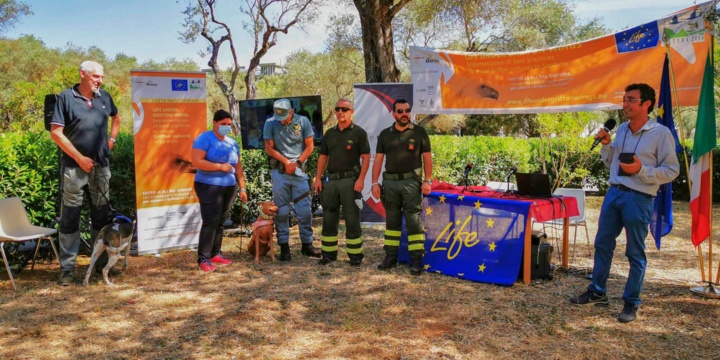The data of the closing conference
14/07/2020
In the last five years in Sardinia, the number of griffon vultures has doubled and the risk of their extinction from the island has significantly decreased: there are now 250 griffon vultures, with an increase in the number of territorial pairs (from 35 to 57) and in the number of newborns. These are the main results of the Life Under Griffon Wings project, which started in 2015 and will end on August 31. The intervention, financed by the Life Programme for the conservation of this vulture, has been carried out by the University of Sassari together with the Forestas Agency, the Forestry and Environmental Supervision Corps and the Municipality of Bosa.
On July 10 in the gardens of the Department of Veterinary Medicine of Sassari were presented the results of the project. On the island - in Bosa and Porto Conte - there is the only natural colony of griffon vulture present in the Mediterranean: in the last decades the demographic situation had become critical. This intervention has thus become necessary to increase the conservation status of the population and mitigate the main threats to its survival.
To achieve these objectives, for the first time in Italy, a network of feeding stations has been set up which, together with the two "set up" of Porto Conte and Monte Minerva of the Forestas Agency, guarantee both the availability of sufficient food for the vulture population and the healthiness of the carcasses. Then the vitality of the population was improved with a repopulation program that led to the introduction of 63 griffon vultures into our skies: 58 from Spain and 5 bred in the Artis Zoo in Amsterdam. In order to face the threat of poisoning, considered the main threat to the conservation of vultures, for the first time in Sardinia an Anti-Poison Dog Unit was set up, composed of agents of the Forestry and Environmental Surveillance Corps of the Inspectorates of Sassari and Oristano, four dogs trained by the Department of Veterinary Medicine and conductors of the Yellow Cross of Ploaghe: the activity of the Unit led, among other things, to the indictment of two breeders for animal poisoning.
The Bonassai Wildlife Rescue Centre of the Forest Agency has been reinforced with the provision of large aviaries for the care and rehabilitation of large vultures. Finally, various actions have been activated to reduce human disturbance in reproductive sites: the Ethical Codes of Naturalistic Photography and Hiking have been prepared, the "Sentieri del Grifone" in Porto Conte and Monte Minerva have been equipped, several awareness campaigns have been launched and two Infopoints have been opened in Prigionette and Bosa, the latter managed directly by the Municipality.
An unexpected result was recorded in 2019, when a couple of Capovaccai - an extremely rare species in Italy - settled and nested in Punta Cristallo (Alghero). The presence was favoured by the presence of the prepared carnaio and the conservation measures implemented with the collaboration of the Regional Park of Porto Conte. The pullo was renamed "Primo", being the first vulture born in Sardinia. The couple nested again this year.
All this work has been made possible thanks to the collaboration of environmental associations, committed for decades to the conservation of the griffon vulture, the Regional Department of Environmental Protection and Health, the Vulture Conservation Foundation, the Regional Natural Park of Porto Conte, the Experimental Zooprophylactic Institute of Sardinia and the veterinary services of the Local Health Authorities of Sassari, Oristano and Nuoro.
"The key to success has been the possibility to intervene on several threats at the same time - explain the project managers - but if today the griffon vulture in Sardinia is living its best season since the 1970s, it is necessary to continue working without lowering its guard. Looking towards the sky, satisfaction is great. And going to "griffon vulture" - this is how we have renamed the outputs for monitoring - the visual perception that this species is increasingly becoming the symbol of this territory and of the agro-pastoral world is a source of pride for all Sardinians".




